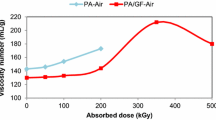Abstract
Experiments are described in which single fibres, embedded in a polyester resin, were immersed in water at various temperatures for various times, and the fibres then pulled out. The effect of the water on the polymer was also investigated. It was found that the fibre-polymer bond strength was reduced almost to zero after 400 h in 75°C water, but at 60°C the reduction was only 40%–50%, even after 13 000 h immersion and at 22°C the strength was reduced by 20% after 13 000 h immersion. Bond strength recovered when the samples were dried out at 80°C for 72 h. The polymer was not much affected by the water. Silane coupling agents were found to give considerable protection against water attack, were effective when only present as a very thin chemisorbed layer on the fibres and thin layers gave greater dry bond strengths than thick layers. Excess coupling agent was not only less effective, but also reduced the properties of the polymer, especially with respect to its resistance to water. These results are compatible with well-established concepts, i.e. that water is absorbed preferentially at the fibre surface, and this is inhibited by the silane.
Similar content being viewed by others
References
E. P. Plueddemann, “Silane Coupling Agents” (Plenum Press, New York, 1982) Ch. 1.
G. Pritchard andN. Talreja,Composites 4 (1973) 181.
A. Blaga andR. S. Yamasaki,J. Mater. Sci. 8 (1973) 1331.
O. Ishai andU. Arnon, ASTM STP 658(American Society for Testing and Materials, Philadelphia, 1978) 267.
A. Akhtar andJ. Y. Wong,J. Comp. Tech. Res. 9 (1987) 95.
A. Bledzki, R. Spande andG. W. Ehrenstein,Comp. Sci. Tech. 23 (1985) 263.
M. S. W. Woo andM. R. Piggott,J. Comp. Tech. Res. 9 (1987) 162.
Idem., ibid. 10 (1988) 16.
J. M. Marshall, G. P. Marshall andR. F. Pinzelli,Polym. Comp. 3 (1982) 131.
M. S. W. Woo andM. R. Piggott,J. Comp. Tech. Res. 10 (1988) 20.
J. S. Ghotra andG. Pritchard, “Developments in Reinforced Plastics”, Vol. 3, edited byG. Pritchard (Elsevier Applied Science, London, 1984) p. 63.
P. S. Chua, andM. R. Piggott,J. Mater. Sci. 27 (1992) p. 913.
M. R. Piggott,Comp. Sci. Tech. 42 (1991) 59.
Author information
Authors and Affiliations
Rights and permissions
About this article
Cite this article
Chua, P.S., Dai, S.R. & Piggott, M.R. Mechanical properties of the glass fibre-polyester interphase. J Mater Sci 27, 919–924 (1992). https://doi.org/10.1007/BF01197642
Received:
Accepted:
Issue Date:
DOI: https://doi.org/10.1007/BF01197642




